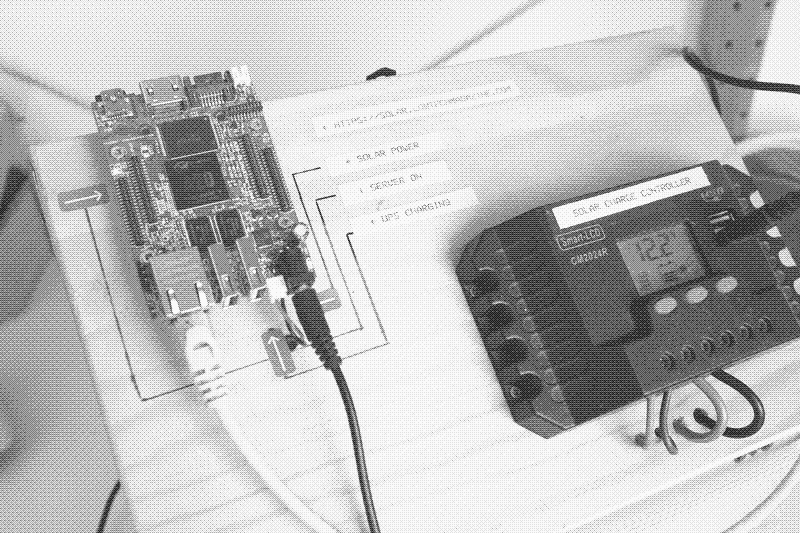Low-tech Magazine was born in 2007 and has seen minimal changes ever since. Because a website redesign was long overdue — and because we try to practice what we preach — we decided to build a low-tech, self-hosted, and solar-powered version of Low-tech Magazine. The new blog is designed to radically reduce the energy use associated with accessing our content.
Dare I call this a tech fetish of mine now? Didn’t know there was an entire class of individuals pursuing this type of thing.
Edit: I’m currently reworking my website to follow low-tech (minimal bandwidth and computation power) design principles.
DIY solar projects are indeed a fun activity. I am currently converting some servers to take 12V input and will probably run them off solar starting next spring
That’s awesome. This type of project would work great for me currently since I live in a part of the US with the highest solar potential, but next year I’m moving to Alaska. This would affect uptime in the winter months for sure.
I live in AK and know a few people with solar setups, it depends a lot on how much south facing exposure you have, etc. There are seismic stations and stuff here that keep near 100% annual uptime here on purely solar, so it’s totally doable, but can be tough.
The summers are great just due to the increased number of daylight hours. I used to live in Fairbanks and that would have been ideal, but the summers up there are plagued with wildfire smoke which greatly affects solar potential.
Yeah I’ll have to look into the engineering of the seismic stations. I reckon their panels are all placed in the perfect spots. I’m just unsure at the moment what kind of living accommodations I’m going to have up there.
I even got into dithering images.
How has this been going? I’ve been messing around with imagemagick this evening and haven’t gotten really close to the kind of dithering I see in their images.
So far I’m using
convert -monochrome -ordered-dither o2x2I use didder, so I’m not sure how the commands would translate, but there is an example code on the didder manual that spits out almost exactly what is on the magazine’s solar site. The manual has an example image for you to play around with as well.
I use this one for some kind of contents https://bearblog.dev
Nice recommendation!
This site is my bible. I’ve been meaning to start hosting my website from home as my country is 100% renewable energy. Still haven’t gotten around to it though but I hope to do so soon. Thanks for posting this as it’s always good to be reminded about this cool project.
I wonder how much traffic you have to get for the manufacturing and shipping costs of a battery, solar panel, own server, etc. to outweigh the carbon footprint of adding a small incremental load to a shared hosting provider which resides in a conventional datacenter?
Batteries, solar panels (the ones that they have), and their server (which is just a small raspberry pi) could all probably be shipped in an average sized box. Don’t take my word for it though, the owner has worked through this mentally as well:
I wonder how much it costs to build & operate a huge datacenter, develop specialized server CPUs, pay all the staff, build large centralized fiber gateways etc, compared to adding a small SBC based on a cheap mass-produced Smartphone SoC to a domestic internet connection and solar system that already exists (or should exist anyways).
As you can see, it is all a matter of perspective…
Yes though it’s not really a symmetrical comparison. Let me make an analogy: suppose for transport I’ve been using a public diesel bus and I’m growing upset about the environmental impact of this vehicle. Instead I buy an ebike which is exclusively for my own use.
When I do this the bus is still operating. For some people an ebike is never going to be an acceptable substitute. There are many reasons including age/physical ability, baggage or distance requirements, or a need to travel during bad weather. By not taking the bus, all I’ve saved is the extra diesel that was burnt due to my body’s mass being aboard the vehicle, a small contribution to the overall system.
If my own traffic is very low - let’s take it to an extreme and say I travel only a short distance once per month - then in terms of carbon emissions it would have been better to burn slightly more diesel than to have my own ebike. As my level of use increases, at some point it becomes more environmentally friendly to have the ebike.
Scalability isn’t a completely linear thing - when you are meeting a lot of people’s requirements simultaneously you end up with resources which are going to be committed anyway, which gives savvy users the ability to “freeload” on incremental costs only.
In this situation other “person” taking the bus are multiples times heavier than the ones taking the ebike. Inducing a strain not only on the bus but roads as well.
Imo we have to see this site as a statement : it’s possible to build low tech , light website, running off-grid.
Sure, but one difference is that new data-centers get build all the time because of high demand. If some of that is substituted by hosting on a SBC from home, then that is probably a net positive for the environment.
So your bus metaphor is only half applicable, and the choice would be rather between upgrading an existing bicycle with an electric motor Vs. building and running a new diesel bus.






